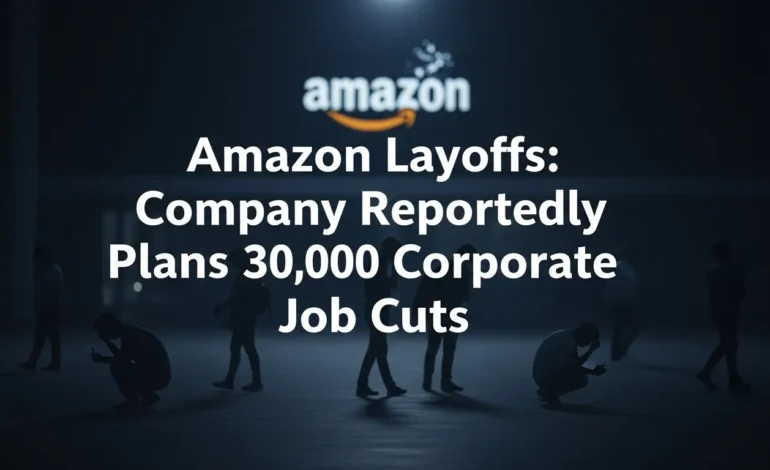Amazon Layoffs: Company Reportedly Plans 30,000 Corporate Job Cuts

Table of Contents
Amazon layoffs have made headlines as the e-commerce giant prepares to eliminate up to 30,000 corporate positions starting October 28, 2025. This marks the largest workforce reduction in company history and affects nearly 10 percent of its corporate staff.
What Are the Amazon Layoffs About
The Amazon layoffs represent a major shift in how the company manages its workforce. Reports from multiple sources confirm that Amazon plans to cut around 30,000 corporate jobs. This number is small compared to the company’s total workforce of 1.55 million people. However, it impacts about 10 percent of the 350,000 corporate employees.
The job cuts began rolling out on October 28 through email notifications. Managers received training on October 27 to prepare for delivering the news to affected workers. The company has not released an official statement about these cuts.
These Amazon layoffs surpass the previous record set in late 2022. During that period, the company eliminated approximately 27,000 positions over several months. The current round of cuts is larger and affects more divisions within the organization.
Which Departments Face Job Cuts
The Amazon layoffs will impact several key departments across the company. The human resources division faces some of the deepest cuts. This department is known internally as People Experience and Technology, or PXT. Reports suggest PXT could lose up to 15 percent of its staff.
Other affected areas include operations, devices and services, and Amazon Web Services. The cloud computing division AWS, despite being the company’s most profitable unit, is not immune to these reductions. Teams working on communications, Alexa devices, and podcasting will also see job losses.
Warehouse workers and delivery staff are not part of these cuts. The layoffs focus exclusively on corporate roles such as technology positions, administrative functions, and management. This distinction is important because most of Amazon’s employees work in warehouses and fulfillment centers.
Why Is Amazon Cutting Jobs
CEO Andy Jassy drives the Amazon layoffs as part of his efficiency campaign. Since taking over from founder Jeff Bezos in 2021, Jassy has worked to eliminate what he calls excess bureaucracy. He aims to make Amazon operate like the world’s largest startup.
The company overhired during the pandemic when online shopping demand surged. Now Amazon needs to correct that expansion and reduce costs. The layoffs help the company compensate for adding too many employees during peak demand periods.
Artificial intelligence plays a major role in these decisions. Jassy stated in June 2025 that AI tools would lead to fewer jobs. He explained that AI automates many routine and repetitive tasks that humans once handled. This means the company needs fewer people for certain roles while creating demand for different types of positions.
Jassy also created an anonymous complaint line for employees to report inefficiencies. This system generated about 1,500 responses and led to over 450 process changes. These changes help identify areas where the company can reduce staff and improve operations.
How Employees Learn About Layoffs
Affected workers receive notifications through email starting Tuesday morning. The company follows a structured process for delivering this news. Managers underwent training on Monday to prepare for communicating with their teams.
The draft severance email reviewed by multiple outlets promises specific benefits. Employees get full pay and benefits for 90 days following termination. The package also includes additional pay based on length of service. Workers receive one week of pay for every six months worked, with a cap at 20 or 26 weeks depending on location.
Amazon forgives outstanding obligations for signing bonuses or relocation expenses. The company also provides a COBRA coverage stipend that matches the severance duration. These benefits aim to support employees during their transition to new opportunities.

What This Means for Tech Industry
The Amazon layoffs reflect broader trends in the technology sector. As of October 2025, more than 98,000 tech employees lost jobs across 216 companies. This continues the pattern from 2024 when over 150,000 workers faced layoffs.
Major companies including Intel, Microsoft, and Google conducted similar reductions in 2025. Intel cut between 21,000 and 25,000 positions. Microsoft eliminated about 15,000 roles. Meta reduced its workforce by 5,000 to 7,000 employees. These numbers show that Amazon layoffs are part of an industry-wide shift.
Artificial intelligence drives many of these cuts across the tech sector. Companies invest heavily in AI infrastructure while reducing human headcount. This trade-off allows businesses to maintain productivity with fewer employees. However, it raises concerns about job security for white-collar workers.
How the Market Responded
Amazon stock price rose after news of the Amazon layoffs broke. The stock gained 1.3 percent to close at $227.11 on Monday. This positive market reaction shows that investors favor cost-cutting measures.
Wall Street often rewards companies that reduce expenses through layoffs. The stock price increase suggests confidence in Amazon’s strategy to boost efficiency. However, this financial benefit comes at the cost of thousands of jobs and raises questions about corporate priorities.
The company was scheduled to release third-quarter earnings on Thursday, October 31. Investors watched closely to see how these cuts would affect Amazon’s financial performance. The timing of the layoffs just before earnings suggests strategic planning by company leadership.
Click here to read more about Trump Pardons Binance Billionaire Changpeng Zhao.
Employee and Public Reaction
Workers and social media users expressed frustration about the Amazon layoffs. Many criticized the timing just weeks before the holiday season. Reddit users called the move corporate greed and questioned whether AI truly justifies the cuts.
Some employees blamed CEO Andy Jassy directly for the pattern of repeated layoffs. Critics noted that he has conducted multiple rounds of job cuts each year since becoming CEO. Others pointed out that layoffs benefit executives through stock-based compensation while hurting workers.
Public sentiment suggests that AI serves as a convenient excuse for decisions companies wanted to make anyway. Many believe the technology has not advanced enough to replace corporate roles. This disconnect between company messaging and reality frustrates both employees and observers.
Looking Ahead
The Amazon layoffs signal long-term changes in how the company operates. Jassy indicated that AI will continue to reshape the workforce. He expects fewer people in some jobs and more in others as technology evolves.
Amazon still plans to hire 250,000 seasonal warehouse workers for the holiday period. This contrast highlights the company’s approach of cutting corporate costs while investing in frontline logistics. The strategy shows different priorities for different parts of the business.
Future job cuts may occur as Amazon continues to integrate AI tools. The company’s focus on efficiency and automation suggests more changes ahead. Workers across the tech industry face uncertainty about job security as these trends accelerate.
The scale of the Amazon layoffs serves as a warning for white-collar professionals. Even skilled corporate employees in stable companies face displacement as technology advances. This reality challenges traditional career advice and raises important questions about the future of work.




